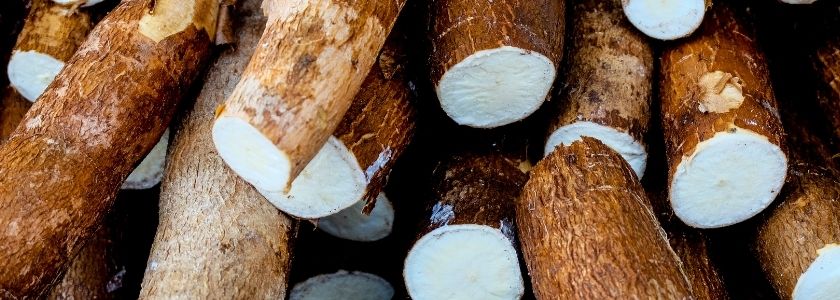CRISPR-editing a crucial food to make it safer for humans

The takeaway: Cassava is a starchy root crop grown in tropical and subtropical regions around the world. The staple feeds billions but produces a toxic cyanogenic compound so it must be processed before it can be safely consumed. Now, a team of researchers has used CRISPR to significantly reduce the presence of cyanide in cassava while also demonstrating the use of genome editing for food safety.
The humble cassava has a huge responsibility.
This plant, which looks like a cross between a potato and a giant carrot, is a woody shrub native to South America but today grown around the world. When harvested, the cassava roots are ground into a coarse flour and then dried (and sometimes also roasted). The resulting foods feed billions. Fufu, a west African staple, is a cassava flour cake smothered in a sauce, while nsima is found in east Africa and is similarly dense and filling. In Brazil, cassava is used in breads, empanadas, rolls, and fritters. In India, cassava is called tapioca and used steamed, boiled, or fried. In Thailand, cassava is often served as a dessert, with coconut cream and shaved ice. In Guyana and Venezuela, it’s even used to make an alcoholic beverage.
But while a critical food source, cassava has a dirty secret: cyanide. The plants must be properly prepared before consumption in order to remove any residual cyanide, which can cause acute cyanide intoxication, paralysis, goiter, and even death.
Cyanide in cassava
Once harvested, cassava begins to deteriorate almost immediately. The tubers respond with a healing method that involves coumaric acids, but the deterioration begins when cyanide is released during harvesting. The plant’s shelf life can be increased by overexpressing a cyanide-insensitive alternative oxidase.
Cassava, when raw, contains two cyanogenic glucosides—linamarin and lotaustralin. They are decomposed by linamarase, an enzyme that is found naturally in the plant. Bitter varieties of cassava may contain up to 1 g/kg of cyanide, and plants grown during drought have even more. Eating raw or improperly processed cassava may result in acute cyanide intoxication symptoms showing up in as little as four hours, and death can occur shortly after. Widespread cyanide poisoning linked to cassava consumption has been reported, particularly when the plant has been eaten raw during times of famine.
CRISPR-editing cassava to remove cyanide
Enter a team of American researchers, who in 2023 published research on their attempt to conduct a CRISPR‑Cas9‑mediated knockout of two genes in cassava tied to cyanide: CYP79D1 and CYP79D2.
“To reduce cyanide levels in cassava, we used CRISPR-mediated mutagenesis to disrupt the cytochrome P450 genes CYP79D1 and CYP79D2 whose protein products catalyze the first step in cyanogenic glucoside biosynthesis,” the researchers wrote. “Knockout of both genes eliminated cyanide in leaves and storage roots of cassava accession 60444; the West African, farmer-preferred cultivar TME 419; and the improved variety TMS 91/02324.”
In their report, researchers said that Agrobacterium-mediated transformation was used to deliver CRISPR-Cas9 genome editing tools into the friable embryogenic calli of cassava accessions, and then later grew the resulting plants. Well-developed growing shoots were maintained in growth chambers and grown under different conditions, which were monitored, watered, and fertilized. Researchers then measured cyanogens from in vitro plantlets and then measured cyanide from adult cassava plants. Leaf and tuberous root samples were collected and tested for cyanide content.
Knockout of CYP79D2 alone resulted in a significant reduction of cyanide, the authors determined, while mutagenesis of CYP79D1 did not. Overall, results of the CRISPR genome editing showed that cassava with less-harmful levels of cyanide can be grown.
"In dual knockout lines generated from the three accessions, the zero (or very near zero) assayed cyanide levels were distinct from those of wildtype and single knockout lines. In each of the three accessions, one CYP79D1 knockout line had cyanide levels distinct from wildtype and the other did not," the authors wrote.
Reduction of cyanide in cassava can do lot of good for cassava growers as well as cassava consumers. Plus, the authors noted, there are positive effects on the environment. Now, detoxing cassava can take days, meaning that this new breed may greatly reduce the amount of time spent in processing. Detoxing is usually done by women and girls, they added, meaning they may have more time to work or go to school. Meanwhile, increased shelf life can have benefits to the entire value chain. To top it off, cyanide byproducts from the processing will no longer be released into wastewater. And everyone benefits from not ingesting cyanide.
What’s next? Extension of the technique to other cultivars.
“The congruence of results across accessions indicates that our approach could readily be extended to other preferred or improved cultivars,” researchers wrote. “This work demonstrates cassava genome editing for enhanced food safety and reduced processing burden, against the backdrop of a changing climate.”
